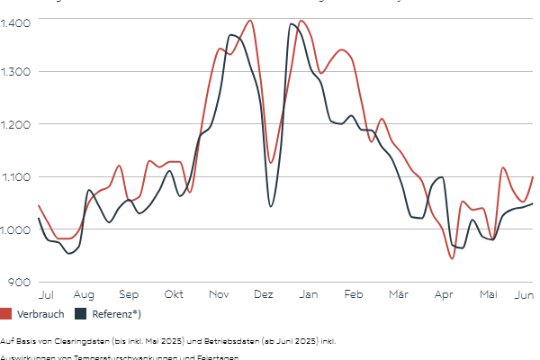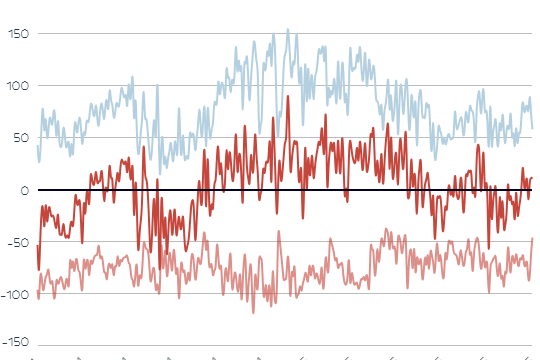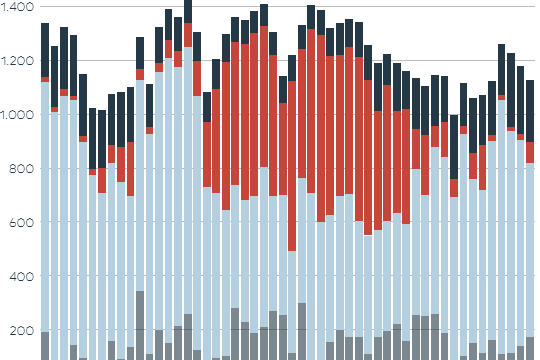June was characterized by very warm temperatures, sunny days and a lack of rain. The lower precipitation compared to the previous year was the main reason for the 17.3% drop in renewable generation (4,309 GWh) in the weeks of June 2025 (calendar weeks 23-26).
While both the share of wind energy (plus 4.6 percent share of renewables compared to June 2024; 542 GWh production in June 2025) and the share of photovoltaic feed-in (plus 3.9 percent share, 809 GWh production) increased compared to June 2024, the share of hydropower (minus 8.7 percent share; 2.838 GWh production) decreased.
Low export balance in June
On balance, exports in Austria (APG* control area) amounted to 275 GWh over the entire month of June (based on the schedules), with electricity being exported on 20 days. Austria was also an export country in the comparative month of June 2024, although electricity was exported on all 30 days, with an export balance of 1,134 GWh. The main reason for this difference was the unusually high run-of-river feed-in in the previous year and particularly low feed-in in June this year.
Need for redispatching
A strong grid is necessary to make the volatile, renewable electricity available and to transport it to where it is needed. To avoid grid overloads and ensure a secure supply, the electricity flow is managed with redispatch measures, i.e., the targeted use of controllable power plants.
As in previous years, enormous costs have been incurred in this context also this year. At 43.5 million euros, these costs in the first half of 2025 were 4.5 million euros higher than the comparable figure for 2024. Ultimately, the electricity customers have to pay these costs, which reflect the lack of grid capacity.
"The urgency of what we have to do becomes evident when we look at these figures and consider the overall system: We have to scrutinize the entire value chain - and not just the generation side. The comprehensive transformation towards a sustainable, resilient, and efficient overall energy system can only succeed with an efficient combination of a transmission grid infrastructure with a higher capacity, a corresponding expansion of renewables, sufficient storage capacities, digitalization of the energy system, and sufficient power plant reserves.", emphasizes Christoph Schuh, company spokesperson for APG.
In addition to the costs related to redispatching measures and higher CO2 consumption, grid management measures also involve the "curtailment" of renewable power plant production. This means, for example, that wind power plants or run-of-river power plants that would be producing electricity at a certain time are shut down to avoid grid overloads. In the first half of 2025, 7,912 megawatt hours (MWh) of electricity (around 1,319 MWh on average per month) were "lost" due to these redispatch measures, which were necessary on 89 days (compared to 83 days by the end of June in 2024).
These figures illustrate the urgent need for a greater grid capacity, which can be used to transport the volatile, renewable electricity to where it is needed.
Energy exchange in the federal territory
Only with the help of a high-capacity transmission grid can electricity surpluses from the individual federal provinces be distributed throughout Austria to compensate for deficits.
In June 2025, the energy exchange within Austria can be summarized as follows: Lower Austria (287 GWh) and Upper Austria (240 GWh) fed the highest volumes of energy into the APG grid, thus making it available throughout Austria. Vienna (457 GWh) and Carinthia (117 GWh) drew the most electricity from the APG grid.
High electrification
Our electricity system faces the challenges of the increasing electrification of all areas of life and the economy, which becomes apparent in the high electricity consumption. Based on the latest available data, 3,994 GWh of electricity was consumed from the public grid in Austria (APG* control area) in June (calendar weeks 23-26)**. Although this represents a minimal reduction of around 3.9% compared to the same month last year (4,155 GWh), it confirms the general trend towards high electrification.
* The APG control area covers all of Austria with the exception of one corridor each in Vorarlberg and Tyrol.
** This is the electricity consumption from the public grid (including grid losses, excluding pumped storage) in the APG control area. The figures do not include electricity produced and consumed by private PV units.
About Austrian Power Grid (APG)
As independent transmission system operator Austrian Power Grid (APG) is in charge of ensuring the security of the electricity supply in Austria. With our high-performance and digital electricity infrastructure and the use of state-of-the-art technologies we integrate renewable energies and reduce the dependency on electricity imports, we are the platform for the electricity market, and we provide access to reasonably priced electricity and thus create the basis for Austria as supply-secure and future-oriented industrial and business location and place to live. The APG grid totals a length of about 3,500 km and is operated, maintained, and continuously adapted to the increasing challenges of the electrification of businesses, industry, and society by a team of approximately 1,000 specialists. 67 substations are distributed all over Austria and the majority is operated remotely. Thanks to our committed employees Austria had a security of supply of 99.99 percent also in 2024 and thus ranks among the top countries worldwide. Our investments of 630 million euros in 2025 (2024: 440 million euros, 2023: 490 million euros) are a motor for the Austrian economy and a crucial factor in reaching Austria’s climate and energy targets. Until 2034 APG will invest a total of approximately 9 billion euros in grid expansion and renovation projects.
Press contact
Christoph Schuh




